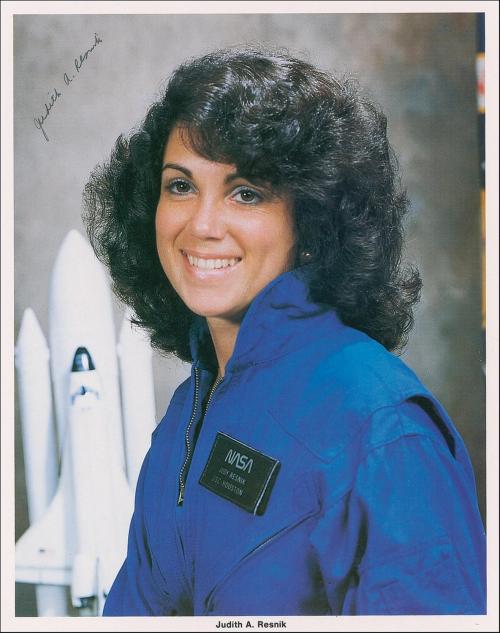#judith resnik
DECEMBER 17 - JUDITH RESNIK
Judith Resnik was recruited into the astronaut program January 1978 by actress Nichelle Nichols, who was working as a recruiter for NASA. Her first space flight was as a mission specialist on the maiden voyage of Discovery, from August to September 1984. She was likewise a mission specialist aboard Challenger for STS-51-L.She was the first American Jewish astronaut to go into space, the first Jewish woman, and at the time only the second Jewish person to go to space (after Boris Volynov of the Soviet Union).
For people accustomed to seeing images of astronauts in space, Resnik’s first space mission still caused some notoriety. Not only was she one of the first women in space, but in weightlessness, she displayed a halo of flowing locks, a startling sight to many viewers who were accustomed to seeing closely cropped men.
During the flight, she was acclaimed for her weightless acrobatics and a playful sense of humor, once holding a sign reading “Hi Dad” up to the camera, and displaying a sticker on her flight locker that advertised her crush on actor Tom Selleck.
Following the Challenger disaster, examination of the recovered vehicle cockpit revealed that three of the crew members’ Personal Egress Air Packs were activated: those of Resnik, mission specialist Ellison Onizuka, and pilot Michael J. Smith. The location of Smith’s activation switch, on the back side of his seat, means that either Resnik or Onizuka could have activated it for him. This is the only evidence available from the disaster that shows Onizuka and Resnik were alive after the cockpit separated from the vehicle. If the cabin had lost pressure, the packs alone would not have sustained the crew during the two-minute descent.
Resnik has been awarded multiple posthumous honors, and has been honored with landmarks and buildings being named for her, including a lunar crater Resnik, located within the Apollo impact basin on the far side of the Moon. A dormitory at her alma mater, Carnegie Mellon, and the main engineering lecture hall at the University of Maryland are named for her. A memorial to her and the rest of the crew crew of Challenger has been dedicated in Seabrook, Texas, where she lived while stationed at the Johnson Space Center.
Text for today’s post was taken from Wikipedia. Please consider donating a few minutes to make a submission to Celebrate Women before the year is over.
Post link
Social Distancing: Challenger: The Final Flight (Docu-Series) - #29
Synopsis: When the Space Shuttle Challenger blew up in 1986, it was the most shocking event in the history of American spaceflight. The deaths of seven astronauts, including the first teacher in space Christa McAuliffe, were watched live on television by millions of viewers. However, what was more shocking was that the cause of the disaster might never be uncovered.
My Take: Many of us were either babies/children or not even born when the Challenger disaster happened, but I think many can recall hearing something about this at least at one point in their life. This series takes an interesting look behind the scenes of the Challenger disaster. I enjoyed learning about the other astronauts on the flight. It seems like when I read or saw discussions about the topic it focused mainly on the teacher – Christa McAuliffe, who was on the flight. It was good to hear about the lives of the others who died in the tragedy. Also, it was interesting learning how NASA worked to improve the racial and gender diversity of the space program, how the decision to send a teacher up in space came about and what the astronaut training process entailed. What was sad and disturbing about this series was of course the untimely deaths of (8) individuals who were on the doomed shuttle, but the fact that those who knew of the deadly risk, under the circumstances, and thus could’ve and should’ve stopped the flight, didn’t, due to the monetary loss that would be suffered. The series highlights what we continue to see in our society, no matter the risk or how much tragedy comes from putting money over lives, sadly, for many, money will always take precedence over lives. This is a good educational series, especially for who’ve always had and interest in the space program and who are not familiar with all that happened with the Challenger disaster.


